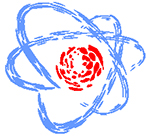Speaker
Maria Popova
(Faculty of Physics, MSU)
Description
Accroding to modern scientific concept, most of stable nuclei heavier than iron were formed as a result of s- and r-processes in stellar nucleosynthesis. However, there is a group of neutron-deficient stable nuclei called bypassed which mechanism of formation has not been elucidated yet. 84Sr and 92Mo belong to this group. One of the hypotheses designed to explain their origin is a chain of successive photonuclear reactions on isotopes formed by the s- or r- process. However, modelling does not allow one to obtain the observed prevalence of bypassed nuclei. The reason may lie in the wrong estimation of the cross sections, especially for reactions with proton emission. Most cross sections of photonuclear reactions at the average (in particular, on isotopes of strontium and molybdenum) and heavy nuclei were obtained by direct measurement of the emitted particles, potentially leading to large systematic errors. The activation technique used by us to conduct an experiment designed to evaluate the reliability of the cross sections obtained is free of these disadvantages.
As a result of this work, irradiation of natural isotope mixtures of strontium and molybdenum with bremsstrahlung at an upper limit Eγmax = 55.6 MeV, measurement and decoding of γ-spectra of residual activity, calculations of experimental and theoretical yields of photonuclear reaction products based on various models and experimental cross sections and their comparison for reactions on natural isotope mixtures of strontium and molybdenum, with the yields of some being measured for the first time. The obtained results were compared with the results of calculations based on the TALYS model [1] using standard parameters and including isospin splitting, as well as the combined model of photonucleon reactions [2], and with the available experimental cross sections. As it is shown in our study, taking into account the isospin splitting is necessary for a correct description of the cross sections of photonuclear reactions with emission of protons and reactions with emission of two neutrons. In general, the difference between the models is manifested for the component T>, which has a larger excitation energy. But, as shown by our experimental data, the standard TALYS program can incorrectly describe the photoproton cross section for the component T<.
[1] Capote R. et al. Belgya T., Bersillon O. Iaea-tecdoc-1506, 2006.
[2] Orlin V.N. Ishkanov B.S. Yadernaya fizika, 78(7-8):601, 2015.
Authors
Alexander Kuznetsov
(SINP)
Maria Popova
(Faculty of Physics, MSU)

